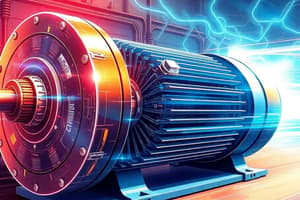Podcast
Questions and Answers
What is the primary function of the stator core in a three-phase induction motor?
What is the primary function of the stator core in a three-phase induction motor?
- To regulate the speed of the motor
- To carry the alternating flux (correct)
- To provide electrical supply to the rotor
- To house the rotor conductors
Why is the stator core laminated in a three-phase induction motor?
Why is the stator core laminated in a three-phase induction motor?
- To minimize eddy current loss (correct)
- To enhance insulation properties
- To reduce mechanical stress
- To improve thermal conductivity
What type of winding is primarily used in squirrel cage induction motors?
What type of winding is primarily used in squirrel cage induction motors?
- Cross winding
- Parallel winding
- Delta winding (correct)
- Single phase winding
Which feature distinguishes a squirrel cage induction motor from a slip ring induction motor?
Which feature distinguishes a squirrel cage induction motor from a slip ring induction motor?
What material is typically used for the rotor conductors in a squirrel cage induction motor?
What material is typically used for the rotor conductors in a squirrel cage induction motor?
What is a significant advantage of a slip ring induction motor compared to a squirrel cage motor?
What is a significant advantage of a slip ring induction motor compared to a squirrel cage motor?
In a three-phase induction motor, what happens if the rotor does not remain concentric with the stator?
In a three-phase induction motor, what happens if the rotor does not remain concentric with the stator?
What is the role of end rings in a squirrel cage induction motor?
What is the role of end rings in a squirrel cage induction motor?
What type of starting method is commonly used for a squirrel cage motor?
What type of starting method is commonly used for a squirrel cage motor?
What is the primary function of the stator in a three-phase induction motor?
What is the primary function of the stator in a three-phase induction motor?
Which type of rotor is commonly associated with a three-phase induction motor?
Which type of rotor is commonly associated with a three-phase induction motor?
Which component is NOT part of the stator in a three-phase induction motor?
Which component is NOT part of the stator in a three-phase induction motor?
What is the typical distance called that exists between the rotor and stator of a three-phase induction motor?
What is the typical distance called that exists between the rotor and stator of a three-phase induction motor?
What is a significant advantage of three-phase induction motors over other types of motors?
What is a significant advantage of three-phase induction motors over other types of motors?
What is the primary purpose of adding a fan to a three-phase induction motor?
What is the primary purpose of adding a fan to a three-phase induction motor?
What percentage of mechanical power in industries is provided by three-phase induction motors?
What percentage of mechanical power in industries is provided by three-phase induction motors?
What component of stator current I0 provides the magnetic flux in an induction motor?
What component of stator current I0 provides the magnetic flux in an induction motor?
How does the rotor reactance X2 change with respect to slip s in an induction motor?
How does the rotor reactance X2 change with respect to slip s in an induction motor?
During the no-load condition, what percentage of the rated current does the no-load current I0 typically reach in an induction motor?
During the no-load condition, what percentage of the rated current does the no-load current I0 typically reach in an induction motor?
What is the equivalent representation of the no-load current I0 in an induction motor?
What is the equivalent representation of the no-load current I0 in an induction motor?
At the locked rotor condition, how is the induced rotor voltage E2s related to the rotor voltage at standstill E20?
At the locked rotor condition, how is the induced rotor voltage E2s related to the rotor voltage at standstill E20?
What is a key feature of a squirrel cage induction motor compared to a slip ring induction motor?
What is a key feature of a squirrel cage induction motor compared to a slip ring induction motor?
In which scenario is a slip ring induction motor preferred over a squirrel cage induction motor?
In which scenario is a slip ring induction motor preferred over a squirrel cage induction motor?
What is the effect of rotor slip on induced EMF during the running condition of an induction motor?
What is the effect of rotor slip on induced EMF during the running condition of an induction motor?
During the production of a rotating magnetic field in a three-phase supply, how are the currents in the windings related?
During the production of a rotating magnetic field in a three-phase supply, how are the currents in the windings related?
What characterizes rotor copper losses in a squirrel cage induction motor?
What characterizes rotor copper losses in a squirrel cage induction motor?
What is the relationship between power input to the rotor and the gross mechanical power developed by the motor?
What is the relationship between power input to the rotor and the gross mechanical power developed by the motor?
Which of the following is true for both types of induction motors regarding maintenance?
Which of the following is true for both types of induction motors regarding maintenance?
What is a disadvantage of using slip ring induction motors compared to squirrel cage induction motors?
What is a disadvantage of using slip ring induction motors compared to squirrel cage induction motors?
Which type of motor is widely used in applications requiring simplicity and low cost?
Which type of motor is widely used in applications requiring simplicity and low cost?
What happens to rotor parameters as the slip decreases during the running condition of an induction motor?
What happens to rotor parameters as the slip decreases during the running condition of an induction motor?
What is the correct relationship expressing the rotor copper loss in terms of slip and rotor input power?
What is the correct relationship expressing the rotor copper loss in terms of slip and rotor input power?
In the context of induction motors, how is the developed mechanical power (Pmd) calculated?
In the context of induction motors, how is the developed mechanical power (Pmd) calculated?
Which factor is key to determining the useful power (Po) of an induction motor?
Which factor is key to determining the useful power (Po) of an induction motor?
What does the ratio P2 : Pc : Pm signify in an induction motor's power flow?
What does the ratio P2 : Pc : Pm signify in an induction motor's power flow?
What is the key input to the rotor of an induction motor that directly affects performance?
What is the key input to the rotor of an induction motor that directly affects performance?
How does the mechanical torque available to drive the load relate to the gross mechanical torque produced by the rotor?
How does the mechanical torque available to drive the load relate to the gross mechanical torque produced by the rotor?
In the power flow diagram, rotor copper losses are determined by which equation?
In the power flow diagram, rotor copper losses are determined by which equation?
What happens to rotor core losses as the speed of the induction motor increases?
What happens to rotor core losses as the speed of the induction motor increases?
Which equation relates the development of mechanical power to rotor input power?
Which equation relates the development of mechanical power to rotor input power?
What represents the input power to the induction motor in the power flow calculations?
What represents the input power to the induction motor in the power flow calculations?
Flashcards are hidden until you start studying
Study Notes
Three Phase Induction Motor Construction
- The most widely used electrical motor in industries (approximately 80% of mechanical power).
- Simple and rugged construction, low cost, good operating characteristics, absence of commutator, and good speed regulation.
- Power is transferred from stator to rotor through induction.
- Two main parts: Stator (stationary) and Rotor (rotating).
Stator
- Stator Frame:
- Outer part, made of cast or fabricated steel.
- Supports stator core and field winding.
- Provides structural strength and protection.
- Stator Core:
- Made up of laminated silicon steel sheets to reduce eddy current losses.
- Designed to carry the alternating flux produced by the winding
- Stator Winding:
- Placed in the slots of the stator core.
- Supplied with three-phase AC power, either star or delta connected.
- Produces the rotating magnetic field that drives the rotor.
Rotor Types
- Squirrel Cage Rotor:
- Simple and robust construction.
- Has slots on its periphery filled with aluminum, brass, or copper bars called rotor conductors.
- Bars shorted at the ends by end rings, forming a closed circuit resembling a cage.
- Has low rotor resistance.
- Widely used due to simplicity and durability.
- Found in lathes, drilling machines, fans, blowers, etc.
- Slip Ring Rotor (Wound Rotor):
- More complex construction with windings similar to the stator.
- Rotor has slip rings and brushes that allow external resistance to be added to the rotor circuit.
- This provides control over starting torque and speed regulation.
- Used in applications requiring high starting torque, like hoists, cranes, and elevators.
Rotating Magnetic Field
- Produced when three-phase winding is energized by a three-phase supply.
- The magnetic field rotates at a constant speed (synchronous speed) which depends on the frequency and number of poles in the stator winding.
- The magnitude of the rotating field is constant.
Principle of Operation
- The rotating magnetic field induces an electromotive force (EMF) in the rotor bars, known as rotor emf.
- The induced EMF causes current to flow through the rotor bars and creates a magnetic field in the rotor.
- The interaction between the rotating magnetic field of the stator and the magnetic field of the rotor creates torque, which drives the rotor mechanical load.
Torque-Slip Characteristics
- The torque produced by the induction motor varies with the speed of the rotor, measured by the slip.
- Slip: defined as the difference between the synchronous speed (Ns) of the rotating magnetic field and the actual speed (N) of the rotor, divided by the synchronous speed.
- Slip (s) = (Ns - N)/Ns
- Starting Torque: High when the slip is 1.
- Maximum Torque: Also known as "breakdown torque," occurs at a specific slip. Exceeding this torque causes the motor to stall.
- Effect of Parameter Variation:
- Rotor Resistance (R2): Increasing rotor resistance increases starting torque but reduces maximum torque and efficiency.
- Rotor Reactance (X2): Increasing rotor reactance reduces starting torque and maximum torque.
Equivalent Circuit
- Used to model the induction motor performance.
- Similar to a transformer circuit, with stator and rotor windings represented as equivalent circuits.
- Allows for the calculation of various motor parameters such as torque, slip, efficiency, and power factor.
- Includes the resistances and reactances of the stator and rotor windings, as well as the effects of the air gap between the stator and rotor.
Phasor Diagram
- A graphical representation of the voltage and current relationships in the induction motor.
- Helps visualize the power factor, slip, and efficiency of the motor.
- Used for analyzing the operation of the motor and for predicting performance characteristics.
Performance Evaluation
- Direct Testing:
- Measurement of motor characteristics directly under operating conditions, including torque, speed, power, and current.
- Indirect Testing:
- Using indirect methods like analyzing the equivalent circuit or phasor diagram to determine performance parameters.
- Circle Diagram:
- A graphical tool derived from the equivalent circuit that provides a comprehensive view of the motor's performance for various operating points.
Construction of Three Phase Induction Motor
- The construction of the three-phase induction motor is important for understanding its operation and performance.
- The stator, rotor, and other components are designed to produce the rotating magnetic field, transfer power effectively, and withstand operating conditions.
- The construction must be robust and efficient to maximize motor lifetime and reliability.
Induction Motor Basics
- The induction motor is similar to a transformer: the stator winding is analogous to the primary winding and the rotor winding is similar to the secondary winding
- The stator current has two components: the magnetizing component (Im) and the current that supplies the motor losses (Iw)
- The rotor winding is short-circuited, which means the entire induced voltage is used to circulate the rotor current (I'2)
- The frequency of the stator and rotor currents is different, but the magnetic fields they produce rotate at synchronous speed (Ns)
- The slip (s) is the difference between the synchronous speed (Ns) and the actual speed of the rotor (N)
- The stator and rotor magnetic fields rotate with the same speed, making the induction motor act like a transformer with an air gap between the primary and secondary windings
Equivalent Circuit of an Induction Motor
- The equivalent circuit is used to predict the performance of an induction motor in steady-state conditions
- The stator circuit model consists of the stator resistance (R1) and stator leakage reactance (X1)
- The no-load current (I0) is represented by a parallel combination of a pure inductor (X0) representing the magnetizing component (Im) and a resistor (R0) representing the core losses
- The rotor model consists of the rotor resistance (R2) and rotor reactance (X2)
- The rotor reactance is proportional to the slip (s)
- The rotor circuit can be modeled by a constant reactance (X20) and a variable resistance (R2/s)
Performance Calculations
- The input power can be calculated by considering the stator losses, core losses, and the power transferred to the rotor
- The air gap power (Pg) is the power transferred from the stator to the rotor
- The developed torque (Td) is proportional to the air gap power and inversely proportional to the slip
- The torque equation helps to understand the relationship between speed, torque, and load conditions in an induction motor.
Studying That Suits You
Use AI to generate personalized quizzes and flashcards to suit your learning preferences.





